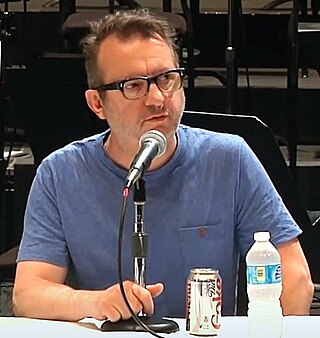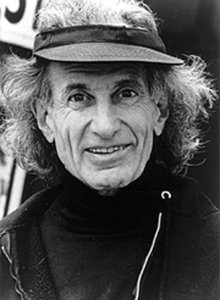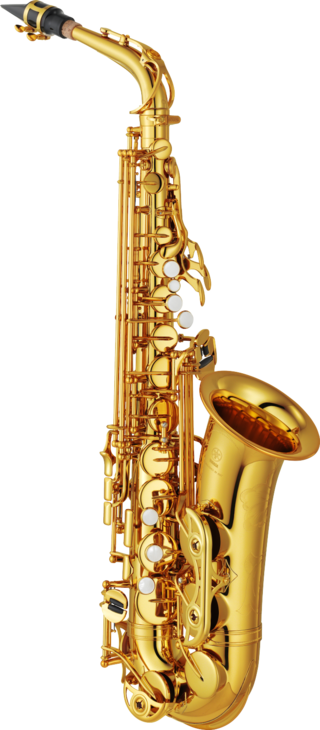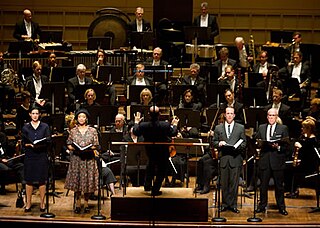Related Research Articles
Ellen Taaffe Zwilich is an American composer, the first female composer to win the Pulitzer Prize for Music. Her early works are marked by atonal exploration, but by the late 1980s, she had shifted to a postmodernist, neoromantic style. She has been called "one of America's most frequently played and genuinely popular living composers." She was a 1994 inductee into the Florida Artists Hall of Fame. Zwilich has served as the Francis Eppes Distinguished Professor at Florida State University.

Mark-Anthony Turnage is an English composer of contemporary classical music.

Henry Dreyfuss Brant was a Canadian-born American composer. An expert orchestrator with a flair for experimentation, many of Brant's works featured spatialization techniques.

The alto saxophone is a member of the saxophone family of woodwind instruments. Saxophones were invented by Belgian instrument designer Adolphe Sax in the 1840s and patented in 1846. The alto saxophone is pitched in the key of E♭, smaller than the B♭ tenor but larger than the B♭ soprano. It is the most common saxophone and is used in popular music, concert bands, chamber music, solo repertoire, military bands, marching bands, pep bands, carnatic music, and jazz.
Frederick L. Hemke(néFred LeRoy Hemke Jr.; July 11, 1935 – April 17, 2019) was an American virtuoso classical saxophonist and influential professor of saxophone at Northwestern University. Hemke helped to increase the popularity of classical saxophone, particularly among leading American composers. He contributed to raising the recognition of the classical saxophone in solo, chamber, and major orchestral repertoire throughout the world. For half a century, from 1962 to 2012, Hemke was a full-time faculty member at Northwestern University's Bienen School of Music. In 2002, he was named Associate Dean Emeritus of the school. He retired in 2012. Throughout his career, Hemke helped build American saxophone repertoire through many composers including Muczynski, Creston, Stein, Heiden, and Karlins. Journalist and author Michael Segell, in his 2005 book, The Devil's Horn, called Hemke "The Dean of Saxophone Education in America." Hemke died on April 17, 2019.

Steven Edward Stucky was a Pulitzer Prize-winning American composer.
Walter Sinclair Hartley was an American composer of contemporary classical music.

Frank Ticheli is an American composer of orchestral, choral, chamber, and concert band works. He lives in Los Angeles, California, where he is a Professor Emeritus of Composition at the University of Southern California. He was the Pacific Symphony's composer-in-residence from 1991 to 1998, composing numerous works for that orchestra. A number of his works have become standards in concert band repertoire.

Augusta Read Thomas is an American composer and University Professor of Composition in the Department of Music at the University of Chicago, where she is also director of the Chicago Center for Contemporary Composition.

Frigyes Hidas was a Hungarian composer.

Thomas M. Sleeper was an American composer and conductor. He was the Orchestra Conductor at Stetson University in DeLand, Florida from 1985 to 1993, and Director of Orchestral Activities and Conductor of the University of Miami Frost Symphony Orchestra until his retirement in 2018. He was also the director of the Florida Youth Orchestra from 1993 to 2020.
David Frederick Stock was an American composer and conductor.

Andreas Makris was a Greek-American composer and violinist, born in Kilkis, Greece, on March 7, 1930. He was a Composer-in-Residence for many years at the National Symphony Orchestra in Washington DC, working with conductors such as Howard Mitchell, Mstislav Rostropovich, Antal Dorati, and Leonard Slatkin. He composed around 100 works for orchestra, chamber ensembles, and solo instruments, including the Aegean Festival Overture, which, transcribed for concert band by Major Albert Bader of the USAF Band, became a popular piece with US bands. Grants and awards he received include the Damroch Grant, National Endowment for the Arts Grant, the Martha Baird Rockefeller Award, ASCAP Award, the Fulbright Scholarship, and citations from the Greek Government.
Timothy M. Ries is an American saxophonist, composer, arranger, band leader, and music educator at the collegiate/conservatory level. Ries is in his eighteenth year as a professor of jazz studies at the University of Toronto. His universe of work as composer, arranger, and instrumentalist ranges from rock to jazz to classical to experimental to ethno to fusions of respective genres thereof. His notable works with wide popularity include The Rolling Stones Project, a culmination of jazz arrangements of music by the Rolling Stones produced on two albums, the first in 2005 and the second in 2008.
Timothy McAllister is an American classical saxophonist and music educator, who, as of 2014, is Professor of Saxophone at the University of Michigan School of Music, Theatre & Dance.
The Oboe Concerto is a composition for solo oboe and orchestra by the American composer John Harbison. The work was commissioned by the San Francisco Symphony for its principal oboist William Bennett. It was completed on October 18, 1991, and was given its world premiere by Bennett and the San Francisco Symphony under the conductor Herbert Blomstedt in 1992.
The Saxophone Concerto is a composition for alto saxophone and orchestra by the American composer John Adams. The work was jointly commissioned by the Sydney Symphony Orchestra, the St. Louis Symphony, the Baltimore Symphony Orchestra, and Orquestra Sinfônica do Estado de São Paulo Foundation. It was given its world premiere in Sydney, Australia on August 22, 2013 by the saxophonist Timothy McAllister and Sydney Symphony Orchestra under the direction of Adams.
Andrew M. Boss is an American composer. He completed his Doctor of Musical Arts at the University of Texas and his masters at the Peabody Institute of The Johns Hopkins University. His teachers include Dan Welcher, Donald Grantham, Russell Pinkston, Kevin Puts, Daniel Crozier, and Donald Waxman. Boss's work, Tetelestai, was commissioned by Jerry Junkin and the University of Texas Wind ensemble and premiered in November 2014. The work reflects the feelings and emotions behind the birth, death, and resurrection of Jesus Christ. The work has received its Australian premiere by John Lynch and the Sydney Conservatorium of Music Wind Symphony in September 2016.
References
- 1 2 Carter, Elliott (2013). "Hemke Concerto 'Prisms of Light'". G. Schirmer Inc. Retrieved March 18, 2016.
- ↑ Doherty, Donna (February 22, 2014). "New Haven Symphony Orchestra fetes noted composer and sax professor". New Haven Register . Retrieved March 18, 2016.
- ↑ Arnott, Christopher (February 27, 2014). "A Light Breeze: Premiere Of A New Sax Symphony At NHSO". Hartford Courant . Retrieved March 18, 2016.